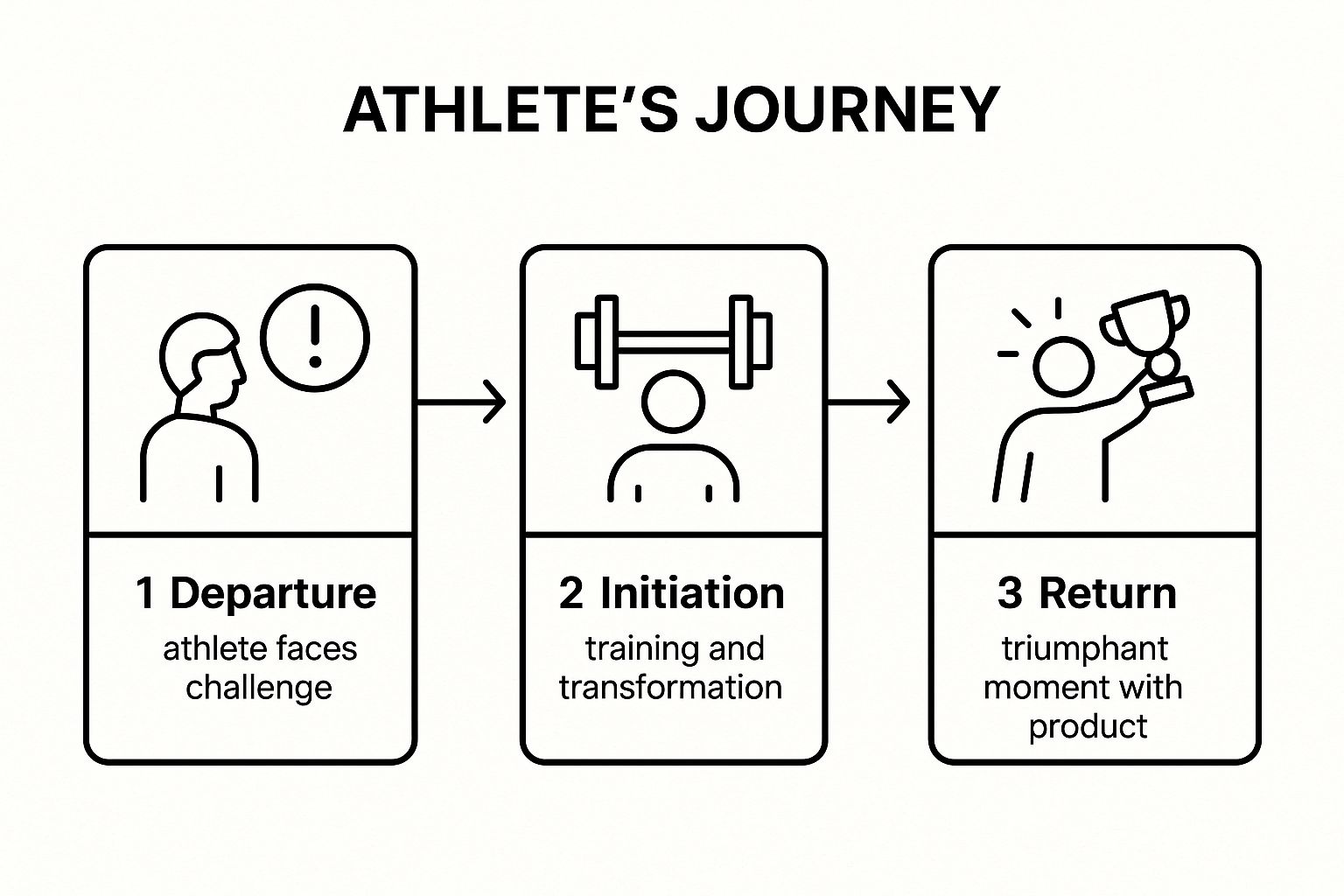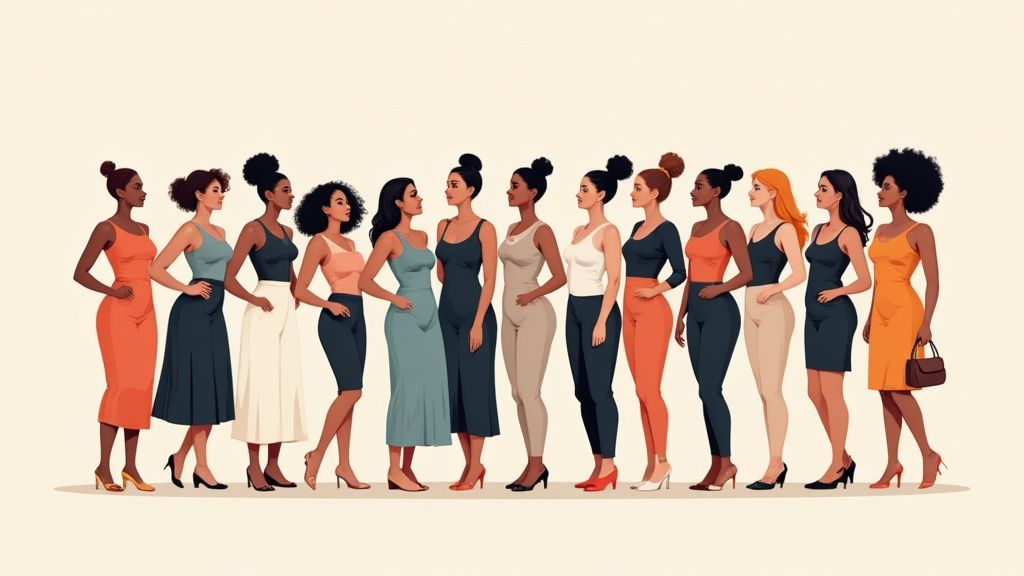7 Storytelling in marketing examples You Should Know

Getting Started
This listicle dives deep into seven powerful storytelling in marketing examples, providing actionable takeaways you can implement in your own campaigns. We'll dissect the strategies behind these successful narratives, revealing why they resonated with audiences and how you can replicate their success. Learn how major brands leverage storytelling to connect with customers on an emotional level, build brand loyalty, and drive conversions. We'll go beyond surface-level descriptions, offering a strategist's perspective on each campaign, highlighting specific tactics, and extracting replicable methods.
Before diving into specific storytelling campaigns, it's beneficial to explore the broader context of visual narratives. For inspiration and practical application, reviewing some general video marketing examples can be particularly helpful. This resource from VideoQi showcases top video marketing examples to boost your strategy, offering a foundation in effective visual communication.
This analysis covers a range of storytelling approaches, including:
- Nike's Hero's Journey Campaign: Discover how Nike uses archetypal narrative structures to connect with its target audience.
- Dove's Real Beauty Documentary-Style Storytelling: Examine the power of authenticity and user-generated content.
- Airbnb's User-Generated Story Platform: See how empowering your customers to share their experiences can fuel brand growth.
- Always' Empowerment Narrative Campaign: Learn how to tap into social movements and create purpose-driven campaigns.
- John Lewis' Cinematic Christmas Storytelling: Uncover the secrets behind crafting emotionally resonant holiday campaigns.
- Patagonia's Environmental Mission Storytelling: Explore how values-based marketing can attract and retain loyal customers.
- Spotify's Data-Driven Personal Storytelling: Understand how to personalize your messaging at scale using data insights.
By the end of this article, you'll have a practical understanding of how to craft compelling narratives that drive results, regardless of your industry or budget. Get ready to unlock the power of storytelling in marketing.
1. Nike's Hero's Journey Campaign
Nike's marketing prowess shines through its consistent use of the Hero's Journey narrative. This classic storytelling framework follows individuals – from elite athletes to everyday people – through challenges, transformations, and ultimately, triumph. This approach positions Nike products not merely as athletic gear, but as essential tools empowering personal growth and achievement. This resonates deeply with audiences, forging a powerful emotional connection with the brand. As you're getting started, it's helpful to see real-world examples. You can find some inspiring storytelling in marketing examples from Mindstamp.
Examples of Nike's Hero's Journey
- "Just Do It" campaigns: These iconic ads often depict athletes overcoming obstacles, mirroring the struggles and victories many experience in their own fitness journeys.
- Colin Kaepernick "Dream Crazy" campaign: This campaign embraced controversy, showcasing Kaepernick's resilience and aligning Nike with social justice, resonating with a specific audience segment.
- Michael Jordan documentaries: These films chronicle Jordan's legendary career, highlighting his dedication and perseverance, further solidifying his iconic status and Nike's association with greatness.
- Serena Williams comeback story campaigns: These showcase Williams' strength and determination, inspiring audiences while subtly promoting Nike's role in her journey.
Why the Hero's Journey Works for Nike
The Hero's Journey taps into universal human experiences of struggle, perseverance, and achievement. This allows Nike to connect with audiences on a deeper emotional level, fostering brand loyalty and inspiring action. By portraying its products as integral to this transformative journey, Nike elevates its brand beyond mere athletic apparel, positioning itself as a partner in personal growth. Learn more about Nike's Hero's Journey Campaign
Actionable Takeaways for Your Storytelling in Marketing Examples
- Identify genuine transformation stories: Look within your customer base for authentic stories of change and growth.
- Focus on the emotional journey: Emphasize the feelings, struggles, and triumphs rather than just the end result.
- Product integration: Ensure your product plays a meaningful role in the transformation, not just a peripheral one.
- Authenticity is key: Use real voices and experiences whenever possible to enhance credibility and emotional connection.
- Universal themes: Build campaigns around relatable concepts like perseverance, resilience, and personal growth.
The infographic below illustrates the core steps of Nike's Hero's Journey narrative structure. This step-by-step process underscores the brand's storytelling approach.

The infographic clearly visualizes the three main stages: Departure (facing a challenge), Initiation (training and transformation), and Return (triumphant moment, often featuring the product). This simple yet effective structure highlights the transformative power of sport and positions Nike as a facilitator in this journey. This campaign structure, applied successfully by Nike and popularized by their advertising agency Wieden+Kennedy (and specifically Dan Wieden, creator of "Just Do It"), can be adapted for various brands and industries. By focusing on the emotional journey and integrating your product meaningfully, you can leverage the power of storytelling to connect with your audience on a deeper level.
2. Dove's Real Beauty Documentary-Style Storytelling
Dove revolutionized beauty marketing by using documentary-style storytelling. This approach focuses on real women's stories and challenges traditional beauty standards. Their campaigns feature authentic narratives about self-acceptance, body positivity, and redefining beauty. This resonates deeply with audiences seeking genuine connections and representation in media.

Examples of Dove's Documentary-Style Approach
- Real Beauty Sketches: This campaign powerfully depicted the gap between women's self-perception and how others see them. An FBI-trained forensic artist sketched women based on their self-descriptions and then based on descriptions from strangers. The stark contrast highlighted the impact of negative self-image.
- Evolution: This short film exposed the extent of digital manipulation in beauty advertising. It showed the transformation of an ordinary woman into a billboard model, revealing the unrealistic beauty standards perpetuated by the media.
- Dove Self-Esteem Project: This initiative provides educational resources to young people about body image and self-esteem. It aims to build confidence and resilience in the face of societal pressures.
- Crown Act Campaign: This campaign supports the CROWN Act legislation, which prohibits discrimination based on hair texture and style. It further emphasizes Dove's commitment to inclusive beauty standards.
Why Documentary-Style Storytelling Works for Dove
Dove's approach fosters genuine connection by addressing real issues that resonate with their target audience. By featuring authentic stories and challenging conventional beauty norms, Dove builds trust and positions itself as a brand that understands and supports its customers. This emotional connection strengthens brand loyalty and drives engagement.
Actionable Takeaways for Your Storytelling in Marketing Examples
- Ensure brand value alignment: Authentically connect your brand values with the stories you share.
- Use real customers: Leverage genuine experiences from your customer base for maximum impact.
- Address real issues: Tap into topics that genuinely matter to your target audience.
- Maintain consistency: Ensure storytelling aligns with your actual business practices.
- Support your narrative: Back up your stories with concrete actions and initiatives.
Dove's documentary-style approach, popularized by their partnership with Ogilvy & Mather and spearheaded by individuals like Tim Piper, demonstrates the power of authentic storytelling in marketing. By focusing on real people, real issues, and real change, Dove has built a powerful brand narrative that resonates deeply with consumers and sets a new standard for beauty marketing. This approach, focusing on genuine connection and social impact, can be adapted by brands across industries to build trust and create meaningful engagement with their audiences.
3. Airbnb's User-Generated Story Platform
Airbnb's marketing brilliance lies in its user-generated story platform. This innovative approach transforms customers into brand storytellers, leveraging authentic travel experiences as the primary marketing vehicle. By fostering a community where guests and hosts share their unique adventures, Airbnb cultivates trust and inspires wanderlust, effectively driving bookings and building brand loyalty. This strategy offers invaluable storytelling in marketing examples for businesses looking to connect with their audience on a deeper level.

Examples of Airbnb's User-Generated Content
- Airbnb Stories Platform: This dedicated platform showcases a diverse range of guest and host experiences, highlighting the personal touch and unique accommodations Airbnb offers.
- "Belong Anywhere" Campaign: This campaign uses authentic travel stories to promote inclusivity and the idea that everyone can find a place to call home with Airbnb.
- Instagram Integration: Encouraging users to share their travel photos with dedicated hashtags seamlessly integrates user-generated content into Airbnb's broader marketing strategy.
- Host Story Features: Highlighting unique accommodations and the personal stories of hosts adds a layer of authenticity and connection, attracting potential guests.
Why User-Generated Stories Work for Airbnb
User-generated content builds trust and credibility. Potential guests are more likely to believe stories from fellow travelers than traditional advertising. This organic approach also fosters a sense of community, making users feel like they are part of something bigger. Learn more about Airbnb's User-Generated Story Platform from this article on cross-platform content strategy.
Actionable Takeaways for Your Storytelling in Marketing Examples
- Create easy-to-use sharing tools: Simplify the process for customers to share their experiences.
- Curate and amplify the best content: Showcase high-quality user-generated stories to maximize impact.
- Incentivize sharing: Offer rewards or recognition to encourage participation.
- Maintain quality standards: Ensure content aligns with brand values while preserving authenticity.
- Address concerns with user stories: Use real experiences to alleviate common anxieties or objections.
This user-generated content strategy, popularized by Airbnb and its founders, offers a powerful model for brands seeking to build trust and create a loyal community. By empowering customers to become brand advocates, businesses can unlock a wealth of authentic stories that resonate deeply with target audiences. This is a key example of storytelling in marketing examples that demonstrates the power of customer voices.
4. Always' Empowerment Narrative Campaign
Always transformed their brand from a functional product advertiser to a champion of female empowerment. They achieved this through compelling storytelling campaigns that address gender stereotypes and support girls' confidence during puberty and beyond. This shift resonated deeply with their target audience, establishing Always as more than just a feminine hygiene brand, but as an advocate for female strength and resilience. This approach has redefined their brand identity and fostered a strong emotional connection with consumers.
Examples of Always' Empowerment Narrative
- "Like a Girl" campaign: This groundbreaking campaign challenged the negative connotations associated with the phrase "like a girl." It showcased how perceptions of girls' abilities change during puberty and highlighted the impact of societal stereotypes.
- "#EndPeriodPoverty" initiative: This campaign addressed the issue of menstrual equity, aiming to provide access to period products for all girls. This showcased Always' commitment to social impact beyond product promotion.
- Puberty education programs and content: Always provides educational resources for girls navigating puberty, offering support and information during a crucial developmental stage. This reinforces their role as a trusted source of information and support.
- Confidence-building workshops and educational materials: These programs equip girls with the tools and resources to build self-esteem and navigate the challenges of adolescence. This demonstrates Always' dedication to fostering positive change beyond product marketing.
Why the Empowerment Narrative Works for Always
By addressing real issues faced by their target audience, Always creates a genuine connection that transcends traditional advertising. They position themselves as a brand that understands and supports girls' experiences, fostering brand loyalty and advocacy. The focus on empowerment and social impact resonates deeply with consumers, differentiating Always from competitors and building a strong brand identity rooted in positive values.
Actionable Takeaways for Your Storytelling in Marketing Examples
- Choose social issues that align naturally with your brand and audience: Authentic alignment enhances credibility and avoids appearing opportunistic.
- Support storytelling with concrete actions and programs: Back up your narrative with tangible initiatives that demonstrate your commitment.
- Engage with your audience's real concerns and challenges: Address genuine needs and anxieties to build trust and foster connection.
- Maintain consistent messaging across all brand touchpoints: Reinforce your narrative throughout all communication channels for maximum impact.
- Measure impact through brand perception and engagement metrics: Track how your storytelling efforts influence brand sentiment and audience interaction.
This campaign structure, popularized by Always and their advertising agency Leo Burnett, demonstrates the power of aligning with social causes. By focusing on genuine empowerment and backing up their narrative with concrete action, Always effectively resonates with their target audience and cultivates a strong, positive brand image. This approach can be adapted by various brands seeking to connect with consumers on a deeper level. By addressing relevant social issues and actively contributing to positive change, brands can foster trust, loyalty, and meaningful engagement.
5. John Lewis' Cinematic Christmas Storytelling
John Lewis, a UK department store, has redefined Christmas advertising through cinematic storytelling. Rather than focusing on product promotion, their annual campaigns tell complete, emotionally resonant stories emphasizing human connection, generosity, and the magic of the season. This approach elevates the brand beyond retail, associating it with cherished holiday values. This creates a powerful emotional connection with audiences, generating anticipation and conversation each year.
Examples of John Lewis' Christmas Storytelling
- "The Boy and the Piano": This ad reversed Elton John's life story, showcasing the piano that sparked his musical journey and highlighting the power of giving.
- "Buster the Boxer": This heartwarming story featured a family dog's joyous reaction to a Christmas trampoline, capturing the excitement and innocence of the holiday.
- "The Man on the Moon": This poignant campaign focused on the loneliness of the elderly during Christmas, encouraging viewers to connect with those who might be isolated.
- "Monty the Penguin": This charming story explored a child's imagination and the special bond of friendship, culminating in a heartwarming Christmas gift.
Why Cinematic Storytelling Works for John Lewis
By prioritizing emotional resonance over direct product promotion, John Lewis creates campaigns that are shared, discussed, and anticipated. This fosters a strong sense of brand loyalty and positive association with the holiday season. The high production values and cinematic quality further elevate the campaigns, making them memorable and impactful. Learn more about John Lewis' Cinematic Christmas Storytelling at this helpful resource on visual storytelling techniques.
Actionable Takeaways for Your Storytelling in Marketing Examples
- Invest in quality: High production values can significantly enhance the impact of your storytelling.
- Focus on universal themes: Tap into emotions and experiences that resonate broadly with your target audience.
- Spark conversation: Create campaigns that encourage discussion and sharing.
- Maintain consistency: Establish a recognizable storytelling style, even as content varies.
- Consider cultural context: Align your storytelling with relevant cultural moments and sensitivities.
John Lewis' Christmas campaigns, often created in collaboration with their advertising agency Adam & Eve/DDB and various prominent directors, demonstrate the power of emotional, cinematic storytelling in marketing. This approach, while requiring significant investment, yields substantial returns in brand building and audience engagement. By prioritizing human connection and shared experiences, John Lewis has crafted a unique and highly effective marketing strategy that resonates deeply with its target audience.
6. Patagonia's Environmental Mission Storytelling
Patagonia stands out as a powerful example of storytelling in marketing. They've woven environmental activism and sustainable practices into their core brand narrative. This approach resonates deeply with environmentally conscious consumers. It positions Patagonia not just as a clothing company, but as a champion for the planet. This resonates deeply with their target audience.
Examples of Patagonia's Environmental Storytelling
- "Don't Buy This Jacket" campaign: This bold campaign challenged consumerism, urging customers to consider the environmental impact of their purchases. It showcased Patagonia's commitment to sustainability, even at the potential expense of sales.
- "The Footprint Chronicles": This interactive tool provides unprecedented transparency into Patagonia's supply chain, revealing the environmental and social costs of each product. This empowers consumers to make informed decisions.
- Environmental documentaries: Patagonia funds and produces films highlighting environmental issues and conservation efforts. This extends their storytelling beyond product promotion, positioning them as thought leaders and activists.
- 1% for the Planet: Patagonia donates 1% of its sales to environmental organizations, further solidifying their commitment to the cause. This demonstrates that their storytelling is backed by real action.
Why Environmental Storytelling Works for Patagonia
Patagonia's authenticity is key to their success. Their values are consistently reflected in their actions, building trust and loyalty among consumers. By educating and empowering consumers, Patagonia creates a community of shared values. This approach cultivates a loyal customer base that connects with the brand on a deeper level than just product preference.
Actionable Takeaways for Your Storytelling in Marketing Examples
- Ensure authentic brand values: Your mission must be deeply ingrained in your company culture, not just a marketing tactic.
- Educate your audience: Use storytelling to inform and empower consumers, not just to sell products.
- Take a stand: Align your brand with a cause you believe in, even if it means taking risks.
- Back up your story with action: Demonstrate your commitment through concrete initiatives and investments.
- Focus on long-term brand building: Building a strong brand based on shared values leads to sustained success.
This campaign structure, showcasing environmental activism and sustainability, can be adapted for various brands and industries. By focusing on authentic values and engaging storytelling, you can connect with your audience on a deeper level, fostering loyalty and driving positive change.
7. Spotify's Data-Driven Personal Storytelling
Spotify demonstrates the power of data-driven storytelling in marketing. By leveraging user listening data, Spotify crafts personalized narratives that resonate deeply with its audience. This approach transforms cold, hard analytics into engaging stories, making users feel seen and understood while subtly showcasing the platform's capabilities. This strategy helps solidify user engagement and brand loyalty. It serves as a powerful storytelling in marketing example.
Examples of Spotify's Data-Driven Storytelling
- Spotify Wrapped: This annual campaign provides users with personalized summaries of their listening habits throughout the year. These summaries include top artists, songs, genres, and even personalized playlists.
- Discover Weekly: This personalized playlist, updated every Monday, introduces users to new music based on their listening history. The narrative here is one of discovery and personalized recommendations.
- Decade Wrapped: This expands on the annual Wrapped campaign to show users their musical journey over a decade, further emphasizing the platform's role in their musical lives.
- Billboard Campaigns: Spotify cleverly uses anonymized user data in humorous billboard campaigns, highlighting quirky listening habits and cultural trends. This approach brings a human touch to data-driven marketing.
Why Data-Driven Storytelling Works for Spotify
Spotify's data-driven approach creates a sense of personal connection. By showcasing individual listening habits, Spotify acknowledges each user's unique musical taste. This personalized approach strengthens user engagement and fosters a sense of community. It positions Spotify not just as a music streaming service but as a companion in musical discovery.
Actionable Takeaways for Your Storytelling in Marketing Examples
- Use data to tell stories that feel personal and meaningful: Go beyond simple metrics. Focus on how your data reflects individual customer experiences.
- Add humor and personality to data presentation: Don't just present dry statistics. Infuse your data stories with humor and relatable insights.
- Make data visualizations shareable and social media friendly: Encourage user-generated content by making your data stories easy to share.
- Respect user privacy while creating engaging narratives: Anonymize data and focus on aggregate trends when necessary. Transparency is key.
- Use data storytelling to demonstrate product value: Show how your product or service enriches customers' lives, like Spotify does with music discovery. This strategy reinforces customer loyalty.
7 Key Storytelling Marketing Examples Comparison
| Campaign | Implementation Complexity 🔄 | Resource Requirements ⚡ | Expected Outcomes 📊 | Ideal Use Cases 💡 | Key Advantages ⭐ |
|---|---|---|---|---|---|
| Nike's Hero's Journey Campaign | High — Requires scripted narrative and production | Significant investment in high-quality content | Strong emotional connection; broad demographic appeal | Brands aiming for inspirational, transformational storytelling | Deep emotional bond; universal appeal; shareable content |
| Dove's Real Beauty Documentary | Medium — Documentary style but ongoing commitment | Moderate to high for real stories and consistent campaigns | Builds authentic brand purpose; sparks social discussion | Brands addressing social issues authentically | Emotional authenticity; differentiating; long-term loyalty |
| Airbnb's User-Generated Story Platform | High — Platform development and community management | Moderate, cost-effective through users' content | Unlimited authentic content; trust and community building | Brands leveraging customer experiences to scale | Cost-effective; strong trust; large content volume |
| Always' Empowerment Narrative Campaign | Medium to High — Messaging and educational content | Moderate with educational and social programs | Emotional bond; social engagement; brand differentiation | Brands addressing social causes relevant to audience | Strong emotional engagement; brand purpose; social impact |
| John Lewis' Cinematic Christmas | Very High — High production values, cinematic storytelling | Very high production and media budget | Cultural buzz; emotional connection; high earned media | Seasonal campaigns aiming for cultural impact | Memorable cultural moments; strong emotional resonance |
| Patagonia's Environmental Mission | Medium to High — Activism, real advocacy storytelling | Moderate, requires authenticity and consistent messaging | Very loyal customers; strong brand differentiation | Mission-driven brands with a clear social/environmental cause | Loyal base; authentic purpose; media attention |
| Spotify's Data-Driven Storytelling | High — Advanced data analysis and visualization | Moderate, leveraging existing data assets | Highly personalized user engagement; massive social sharing | Tech/data-driven brands focusing on personalization | Personalized, shareable content; showcases product value |
Final Thoughts
This exploration of storytelling in marketing examples has revealed the power of narrative to connect with audiences on a deeper level. From Nike's heroic narratives to Spotify's personalized data stories, each campaign demonstrates the versatility of storytelling across different brands and industries. The key takeaway is that effective storytelling isn't about crafting fictional tales; it's about tapping into authentic human experiences and values.
Key Takeaways and Actionable Insights
Let's recap the crucial elements that make these storytelling examples successful:
- Authenticity: Brands like Dove and Patagonia resonate with audiences because their stories are rooted in genuine values and missions. Don't just tell a story; live it.
- Emotional Connection: Whether it's the heartwarming Christmas ads of John Lewis or the empowering message of Always, triggering emotions is key to engagement and memorability. Consider what emotions you want to evoke in your target audience.
- User-Generated Content: Airbnb cleverly leverages the power of its community by providing a platform for user-generated stories. Think about how you can empower your customers to become part of your brand narrative.
- Data-Driven Personalization: Spotify demonstrates the effectiveness of using data to create personalized stories. Explore how you can leverage data to tailor your message and resonate with individual customers.
- Visual Storytelling: From Nike's cinematic campaigns to John Lewis' beautifully crafted ads, strong visuals play a crucial role in amplifying the narrative. Invest in high-quality visuals that complement your story.
The Power of Story
Mastering the art of storytelling in marketing is more than just a trend; it's a fundamental shift in how brands connect with their audience. By weaving compelling narratives, you can build stronger relationships, foster brand loyalty, and ultimately drive business growth. These examples highlight the effectiveness of moving beyond traditional advertising and embracing the power of human connection. They demonstrate how to craft stories that resonate, inspire, and ultimately, convert.
Weaving Your Own Narrative
Start thinking about your brand's story. What are your values? What makes you unique? Who is your target audience, and what stories will resonate with them? Begin by identifying your core message and then explore creative ways to bring it to life through compelling narratives. Consider different formats, from video and written content to interactive experiences, to find the best medium for your story. Experimentation is key, so don't be afraid to try new approaches and learn from your successes and failures.
Ready to take your visual storytelling to the next level? Lumeo is a powerful platform that allows you to build and deploy computer vision applications without writing any code, making it easier than ever to create engaging and interactive visual stories. Visit Lumeo to explore how you can harness the power of computer vision for your marketing campaigns.